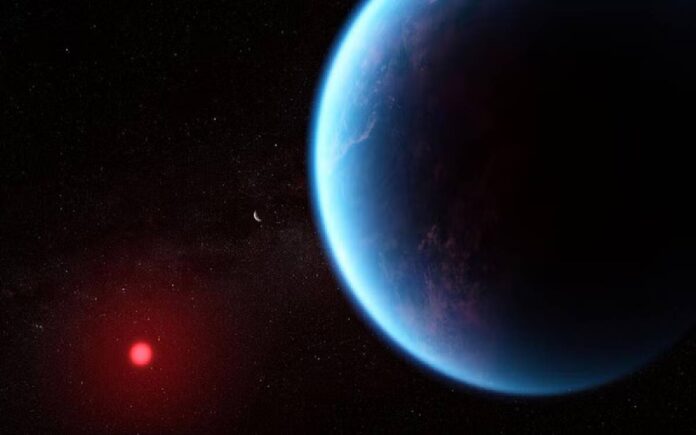Washington, D.C.: In a discovery that could mark a historic milestone in humanity’s search for extraterrestrial life, a team of international researchers has detected the strongest evidence yet of potential life beyond our Solar System. The findings, based on data captured by NASA’s James Webb Space Telescope (JWST), reveal molecular fingerprints in the atmosphere of the exoplanet K2-18 b—including substances that, on Earth, are primarily produced by marine microorganisms.
The exoplanet, located 120 light-years from Earth in the constellation Leo, is over 8.5 times the mass of Earth and orbits a star known as K2-18. This so-called “Hycean world”, a category of planet thought to be covered entirely by ocean beneath a hydrogen-rich atmosphere, has been the focus of increasing attention since earlier studies found methane (CH₄) and carbon dioxide (CO₂) in its atmosphere.
In the latest breakthrough, researchers from the University of Cambridge, led by Professor Nikku Madhusudhan, have now detected dimethyl sulphide (DMS) and dimethyl disulphide (DMDS)—complex organic molecules known to be biosignatures. On Earth, DMS is exclusively produced by marine phytoplankton, and its detection has long been considered a promising sign of biological activity on other worlds.
“We report new independent evidence for dimethyl sulphide and/or dimethyl disulphide in the atmosphere at 3-sigma statistical significance, with high abundance—over 10 parts per million by volume—of at least one of the two molecules”, the team wrote in a paper, currently published as a pre-print in the Astrophysical Journal Letters and yet to be peer-reviewed.
Despite the breakthrough, Madhusudhan emphasizes caution.
“While the results are exciting, it’s vital to obtain more data before claiming that life has been found on another world”, he said. “I’m cautiously optimistic, but we cannot rule out that there may be unknown chemical processes at work on K2-18 b”.
This latest research builds on a 2023 study that revealed abundant levels of methane and carbon dioxide, while ammonia (NH₃) remained absent. The data was consistent with predictions for an ocean-covered planet beneath a temperate hydrogen-rich atmosphere.
“The abundant CH₄ and CO₂, along with the nondetection of ammonia, are consistent with chemical predictions for an ocean under a temperate H₂-rich atmosphere on K2-18 b”, the authors had noted at the time.
In that earlier study, the team had also spotted tentative signs of dimethyl sulphide. The new data, however, was captured using a different JWST instrument and wavelength range, making it an independent confirmation of those earlier hints.
“We didn’t know for sure whether the signal we saw last time was due to dimethyl sulphide, but just the hint of it was exciting enough for us to have another look… The signal came through strong and clear”, said Madhusudhan.
Co-author Subhajit Sarkar from Cardiff University, UK, added, “Finding fingerprints of molecules that hint at possible life poses profound questions concerning the processes that might be producing them”.
The researchers are now planning further studies to determine whether these molecules can be produced through non-biological chemical reactions under the extreme conditions found on K2-18 b.
Though the discovery doesn’t confirm extraterrestrial life, it significantly raises the stakes in the field of astrobiology and offers a tantalizing glimpse into the kinds of worlds that may harbor life far beyond Earth.



